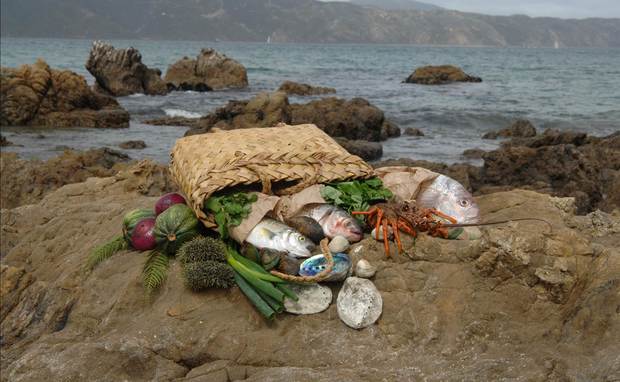 |
Maori developed a set of practical rules to protect the natural habitat, allowing for regeneration. The rules include:
|
Protecting the resource from pollution
Maori have strong beliefs about protecting fisheries resources from pollution. For example, it is forbidden to gut fish in the open seas or throw small fish, excess bait, food or rubbish into the water. Waste like this is seen as attracting predators and polluting sensitive habitats.
Trading with each other
Trading became a common thing to share resources, knowledge on food processing, planting, harvesting, warfare, marriage, funerals, and inter tribal bonding of peoples. Huge amounts of gifts would be exchanged after performing traditional greetings and blessings which were usually followed up with huge banquets
The sorts of items traded were, dried fish, dried eels, vegetables, meats, mats, kete(baskets), cloaks, tools, weapons, slaves. Sometimes things were bartered or exchanged.
The Pace of Change
The pace of change kept accelerating so much so that the Māori diet today is much the same as everyone else in New Zealand.
1772 saw change for Maori to come.
The changes seen were those of discovery, learning and yearning for things that would make life easy for Maori but that yearning for change came at a price and that price was brutal.
That price almost wiped out our people, our lands, our food resources, our history but thankfully the Mana, the Mauri and the ihi stayed intact.. Food for thought when even a vegetable cannot grow alone....it must grow in unity.
Traditional Fisheries
The sea and its fishing grounds were as important to early Maori as the land. The sea was not only a major source of food, but was of customary value as well. Seafood - kaimoana - was the main source of animal protein, fats, vitamins and minerals. It was also a very important way of showing hospitality (manaaki) and generosity at hui or tangi. The food provided for guests is a great status symbol in Maori culture, and kaimoana rates highly. There is a highly organized set of customs - tikanga - to manage the way seafood is gathered and handled.
Preparing and storing fish
Because food from the sea can spoil quickly, it was important to avoid waste by either sharing a large catch or preserving it.
Traditional methods for preserving kaimoana are still used today. Mainly smoking, drying in the sun, cooking it in a hangi and then drying it out for example our pipi. The salting process came later.
Rock lobster and kina were sometimes left in fresh water for a few days before eating. A delicacy we referred to as Koura-mara and Kina Toroi
Shellfish like pipi, kuku, toheroa, tuani, puupuu, was preferred fresh, but most were cooked, dried and threaded on to long strips of flax to keep for reserve food.
* * * *
Shark, seaweed (karengo) and small freshwater fish were also dried. Other seaweeds were eaten fresh or used as food gathering/storage bags. Small whitebait were cooked in leaf packages (tied up , dried in the sun and stored.
* * * *
Fish like snapper, parore and kahawai were filleted and left to hang out and dry during the day and bought in at night to stop mildew setting in during the drying process. This process would take several days to a week pending of course the weather conditions
In the past the roof of their thatched homes were used as drying places with exposure to direct sunlight a key point for drying food. In terms of the sacredness of this process the roof. used would never be used for other uses apart from drying out food.
Eels were cleaned by placing them directly in a fire and rolled into the ashes to burn the slime and skin off then washed later, the insides taken out and maripi was used to cut it up. The eels were always wrapped in flax and tied up before going into the hangi.